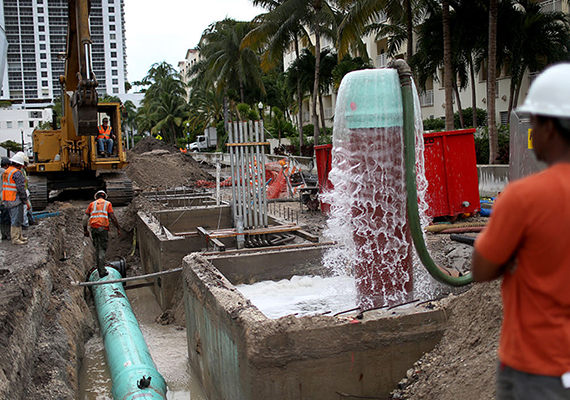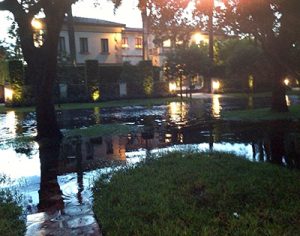Trending
Miami Beach residents push back against plans to raise streets to combat sea level rise
North Bay Road resident Ed Tobin says raising streets will bring flooding into homes


Flooding on North Bay Road in July
After a recent bout of heavy rains, some Mid-Miami Beach homeowners say city sea level mitigation plans could make things worse.
Two weeks ago, developer Matis Cohen was busy helping motorists push their stranded cars as waist-high water flushed through the streets of Miami Beach. Unlike many residents who were hunkered down at home or at work as more than six inches of rain flooded the city in two hours, Cohen was out in the streets, checking on tenants of his rental properties.
Cohen, who said he was lucky to have a Jeep, wants the city to speed up its plans to raise streets and install pumps. “We’ve spent somewhere around $80 million so far out of a $400 million plan, and clearly a system cannot be judged if it is only 15-percent implemented,” he added.
More than six inches of rain knocked out a primary Florida Power & Light feeder, resulting in the loss of several transformers, which in turn cut the secondary power sources used to power pumps. Eric Carpenter, the city’s public works director, called the recent flooding “atypical.”
But some residents of the La Gorce and Lakeview neighborhoods aren’t so convinced as the city prepares to start a $100 million flood-prevention project that will raise street elevations an average of 2 feet in those neighborhoods.
In the meantime, “we are absolutely speeding up some additional back-up power discussions,” Carpenter said, but the city has been stalled in talks with a vendor over the installation of additional generators. The city is authorized to move forward with another contractor on an emergency basis to switch over to temporary generators. The 14 pumps installed so far are doing what they were designed to do, Carpenter said, which is to keep streets up to 2.7 feet dry even during so-called King-tide events when flooding can go higher than two feet.
Miami Beach Mayor Philip Levine won the 2013 election thanks in part to a campaign ad that showed him paddling his dog Earl through flooded streets. Levine, who said “he got flooded into office,” raised storm water fees by 50 to 70 percent, which allowed city officials to get bond money to install pumps and begin raising streets. Nearly all city streets will eventually be raised to a minimum of 3.5 feet and sea walls will be raised to a height of 5.7 feet.
Levine’s efforts have generated global attention, and the city has become a laboratory of sorts for sea level rise mitigation efforts. But some residents are now pushing back against those plans, arguing that it could cause more harm than good – especially in mid-Miami Beach – with trees being ripped out and raised streets sending water into their houses during heavy rains.
Ed Tobin, a 50-year beach resident and a former city commissioner, has long been involved in Miami Beach infrastructure projects. He and his neighbors on North Bay Road have been concerned about what he called “deferred maintenance issues” tied to the city’s storm water drainage system.
“We have drains that are deadlined, that got closed off over the years. We used to have drains in the center of the roadway that have been paved over,” Tobin said, adding that longtime Miami Beach residents are used to some flooding after heavy rains.
Raising streets by 18 inches could “bring other consequences. … Remember the streets are about 22-feet wide. If you eliminate where the water typically settled on the street at 22 feet of area, you push water 22 feet closer to homes,” Tobin said. “So without a significant engineering plan to mitigate all that water that is going to be heading to the homes, you are going to have standing water in living rooms until you can move the water.”
The city is taking those concerns into consideration, Carpenter said. Storm water systems are being designed to handle heavy rainfall not only in public right-of-way areas, but also on adjacent private homes.
“We are designing it in such a way that we are keeping the water levels below finished floor elevations for all of the homes in the neighborhood,” said Carpenter. “When we install the new pumps, we are sizing the pumps to be able to accept not only all of the water on the public right-of-way but handle all the water that falls on private property.”
Carpenter recognized that many residents have “construction fatigue,” when it comes to the disruptions caused by installing pumps and raising roads. As a result, city officials extended the timetable from five to seven years to eight to 10 years. The city now plans to complete the massive project in 2026.
But Tobin said he and his neighbors still have concerns. For residents who have lived in Miami Beach since the ’80s and ’90s, the city has always told them to “be patient and wait” for the city to redo draining systems.
“Most drainage systems in South Florida allow for some amount of water to collect in the street for an hour or so,” he said. “If you are going to eliminate the area where the water typically settles you are going to create a significant problem.”




